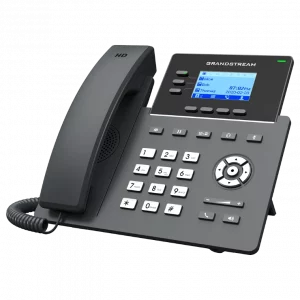
Understanding the Basics of SIP Trunking
As businesses of all sizes transition out of using the traditional public-switched telephone network (PSDN), SIP (Session Initiated Protocol) trunking has become an attractive option.
With significant ROIs and low capital investments, SIP Trunking continues to gain popularity in the commercial market. Keep reading to learn if SIP trunking is the best solution for your business.
Voice Solution Overview
Let’s start with the PSDN. The PSDN is the phone system that is used to connect two parties using a traditional ten-digit telephone number. Service providers manage the system.
In order to get phone service, a business must connect to a service provider that has a connection to the PSDN.
Traditionally, businesses would connect to the PSDN via a service provider using analog lines made of bundles of copper wires.
What is SIP Trunking
SIP trunking replaces the copper wires and analog systems of old with an internet connection. Instead of placing and receiving calls through the PSDN using analog, SIP trunking places those calls via an IP network.
Even with old PSDN connections, many companies used a PBX or key system. This hardware connects the outside PSDN and then acts as an internal branch system to connect individual employees phones to one another and the PSDN.
SIP increases the capacity of a phone system because it allows both data and voice to transmit via a single broadband circuit.
The most important component of SIP is that its data traverses an IP network, which can either be the company LAN or the public internet.
Architecture
Three components are needed to deploy a SIP trunking solution:
- An ITSP. Customers still need a phone provider, but instead of a traditional phone provider that connects them to the system, they now need an Internet Telephone Service Provider.
- A PBX. The PBX can be an older analog model or a new digital PBX, but it must be SIP compatible
- Enterprise border element (a SIP gateway). The gateway manages the network between the ITSP and the PBX.
What to Consider When Purchasing a SIP Trunking Solution
There are several key factors to consider when purchasing a SIP trunking solution.
Support
If your business isn’t up and running at a critical time, day or night, it’s important to know that support is available 24/7.
Backup and Redundancy
Ensure that your SIP provider has several redundancy provisions so that should one part of the network go down, they can reroute all of your traffic to a backup network.
Bandwidth Needs
Because the SIP product works over an internet connection, businesses need to consider all of the hardware that is connected to that network including phones, laptops, desktops, and tablets. Determine how much bandwidth you will need and make sure that the provider
Equipment
A good SIP provider should be able to walk you through their options for equipment. These options can include updating your PBX or key system to be SIP compatible. They will also supply a SIP gateway. Choose a provider that operates with recognized, professional, name-brand equipment.
Security
Security is critical to a SIP trunking solution. No business would want to interact with the public internet without a firewall. Read contracts in detail to ensure that the SIP provider offers full liability in instances of denial or service or data loss or instances of toll fraud.
Network Design
Engage a provider who will create a personalized, fast, reliable and secure solution for your business.
Converting from a PSDN to SIP
A transition from PSDN to SIP follows many of the same steps of any other telecom migration.
SIP trunking vendors offer number portability, allowing businesses to keep the same numbers they’ve had.
Most vendors will recommend that business use temporary numbers to ensure their connection works and to give extra time for the numbers to port.
Corporate firewalls often need to be reconfigured to work with the SIP trunking team, so it’s important that business involve their network administration team as soon as they decide to deploy a SIP solution.
Benefits of SIP Trunking
Businesses that deploy a SIP trunking solution can expect several benefits that include both revenue savings and increases in productivity.
Reduced Cost
SIP trunking is a less expensive way voice solution, especially as compared to traditional PSDN. Without the cost of installing and maintaining fixed copper wire networks, SIP trunking offers a much higher ROI.
Increased Productivity
Most systems offer unified communications features that offer unique personal mobility options to increase productivity. End users can reroute calls to their mobile or home phones while appearing to be on their business line.
Other features associated with unified communications include unified messaging and both voice and video conferencing applications.
Scalability
SIP increases scalability by allowing customers to add capacity quickly and easily.
Service providers sell PSDN lines in bunches. To add capacity requires a physical install which can take days to schedule and adds cost.
SIP allows customers to add channels virtually and in many cases, far more quickly than traditional PSDN systems.
Some ISTPs offer a bursting option, which allows temporary use of additional calling capacity without having to add extra channels permanently.
Easier Maintenance and Disaster Recovery
With traditional phone systems, there are telephone sets, wires, and cables to maintain. Some of these components sit outside and subject to the wear and tear of the elements.
When service goes down, repairmen search through a long trail of often difficult to access service points to find the problem.
With SIP trunking, points of failure are limited to computers, routers, and software. Repairs can be completed quickly and often remotely.
To get calls from the PSDN to a business, and to route calls within the business, many organizations have a key system or a PBX. These are pieces of hardware that can route calls.
SIP Trunking Reduces Cost and Increases Productivity
For businesses looking to streamline and increase ROI on their voice solutions, SIP trunking is a great option.
We’re happy to help bring you a fast and secure SIP solution so contact us today for more information.


